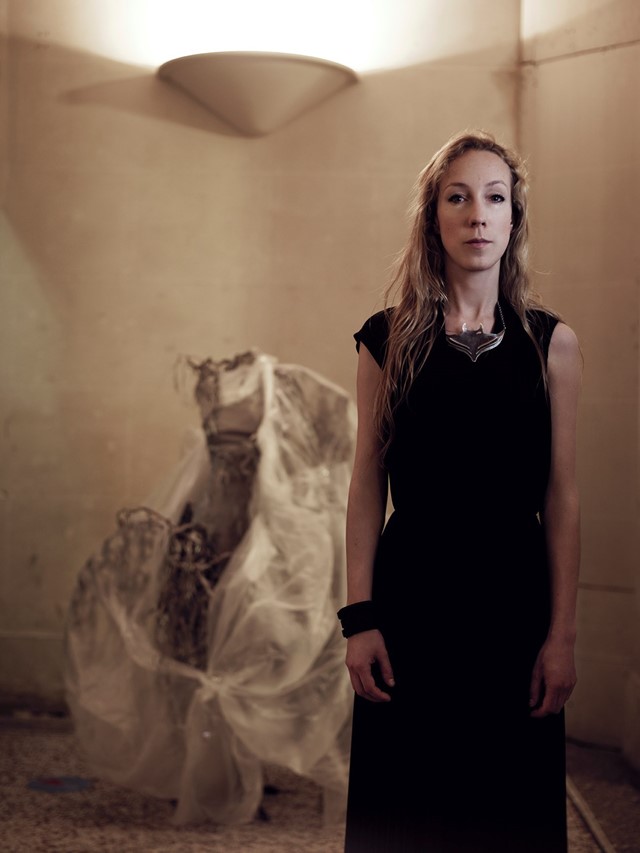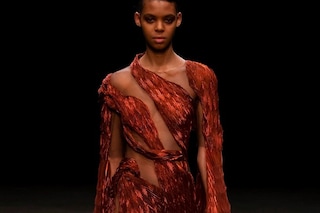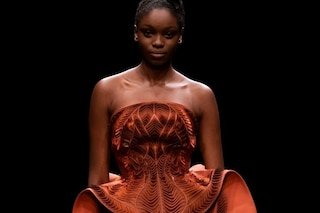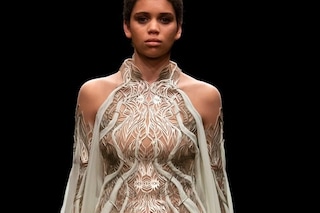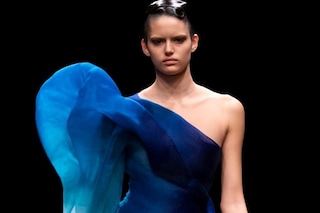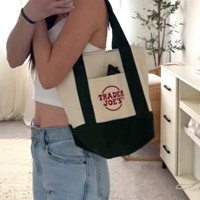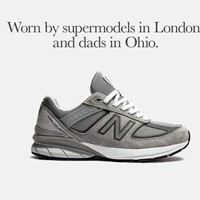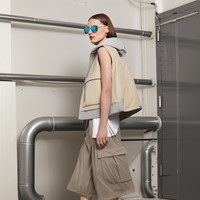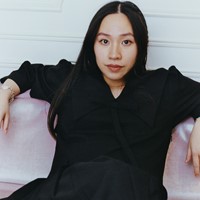The couturier contemplates the state of fashion today, design as meditation, and her lifelong collaboration with Björk
“You see?” Iris Van Herpen is peering out from behind a ghostly fish skeleton, which she has been dangling in front of her iMac. “It’s what we call a liquid fabric. It’s very refined, slightly translucent, and it’s as soft as silk,” she says, fanning its phosphorescent scales with her thumb so that they pucker and domino into neat little rows. Hand-stitched from thousands of miniature petals, it took the best part of six months to develop the sample, which is a cross section of a dress made entirely from recycled Evian bottles. The final design, a prehistoric, almost bioluminescent sculpture, will be worn by Maria Sharapova at this year’s Fashion Awards.
As she stands at her atelier desk overlooking Amsterdam’s gingerbread canal, Van Herpen speaks poetically about the water which flows through it, often getting lost in its many moods and textures, as she does her own train of thought, which meanders into babbling brooks, creeks, and boggy marshes, before circling back into a clear, steady stream. “If you go back into my archives you will find a lot of pieces that are inspired by water, both in crystalline and chaotic form. It's the ultimate source of inspiration for a circular system. It’s our liquid state, the clouds, rainfall, crystals, and the snow. It’s never old, only recycled, for thousands and thousands of years.” It can all sound quite nebulous, especially with Van Herpen, whose collections are born from things like magnetic waves, electricity, and nothingness. But, 14 years after starting her label, she remains at the forefront of design, having forged an encyclopaedia of fabrics with the help of master scientists and architects. “I really see couture as a laboratory of fashion, a beautiful place where there’s time and resources to work on new materials.”
You can just imagine the conversations she has with Marina Abramović, Tilda Swinton, and Björk – who Van Herpen counts as close friends – about vibrations, energy, or transcendental meditation, which is something the designer has recently taken to. That’s bound to make her sound Goop-y (and I loath to even make that comparison) but the designer is lofty and cerebral without any of the new, new age insufferability. She has learnt to push back on those who describe her work as “ethereal” or “otherworldly”, vowing that her designs are rooted in reality. In trees, buildings, and water. “My work tries to reflect the world we are in,” she repeats. Led by intuition, she approaches fashion as if it were “a puzzle or a labyrinth to travel through in order to find answers.” It means she values the process over the product and relies on gut feeling to light the way. What’s truly radical about Van Herpen, however, is the way in which these basic instincts harmonise with technology, transcending both man and machine.
Below, the couturier speaks on the state of fashion today, design as meditation, and her lifelong collaboration with Björk.

Hey Iris, how has your morning been? I’ve just read that the Netherlands are going into another lockdown…
Iris Van Herpen: I feel like I’m surfing! I was finally meant to be going to a festival tomorrow but now that’s been cancelled just like everything else. They say it’s only going to be for three weeks, though. Everything has felt so much more alive and dynamic since we’ve been back together in the atelier, catching up on custom orders and fittings, and we’ve actually got a big deadline in two days so it’s quite hectic at the moment.
You don’t offer ready-to-wear so bespoke orders are really your bread and butter, I suppose. What do you think your clients all have in common?
Iris Van Herpen: They all approach fashion as a form of art. It’s not just about acquiring a garment for them, they want to create a piece of art together, which is a really personal journey and that’s what I love about working with clients, trying to capture their mind. Often we have the same mindset. They’re people who love architecture, dance, or are into science, so conversations go much wider than ‘I like this colour’ or ‘I like this texture’, we talk about the many layers of life. And we have some really young couture clients, too, which is very exciting. We don’t do traditional tulle gowns, everything we do involves technology and innovation, and it tries to reflect the world we’re in. I think that speaks to a younger generation.
Your most recent client was Maria Sharapova, who debuted a dress made from recycled Evian bottles at the Fashion Awards. Can you tell me a little about how that project came about?
Iris Van Herpen: Over the past few years I’ve been focusing more and more on sustainable development, doing lots of experiments to improve the kinds of materials we work with. Then, Evian approached us and asked if we wanted to collaborate on a couture look using their water bottles, and I was really excited. We know that we can create new materials from recycling but the real challenge is to make them haute couture. Nobody would ever imagine a dress with such refinement coming from a plastic bottle. That dichotomy is so beautiful. Around 80 per cent of the fabric is made of recycled yarn from the bottles, the rest is organic silk. I think the yarns are even too thin to show you on Zoom – it’s that impressive. It took a lot of time and resources, though. The material development took around 6 months. Only then did I start sketching.
What was your state of mind when you started putting pen to paper? What came to you?
Iris Van Herpen: I work intuitively and I was actually sitting where I am right now, at my big desk with a view of the river in Amsterdam. There are moments in the day when the water is like a mirror, there’s no movement and it almost becomes a solid surface. Then there are other moments when you start to see textures and little transformations, so I wanted to capture both of those stages of the water, the duality between movement and stillness. I was also thinking of the journey of water more generally, about how it’s the ultimate source of inspiration in terms of recycling and design. It’s our liquid state, the clouds, rainfall, crystals, and the snow. It’s never old, only recycled, for thousands and thousands of years. It’s just a beautiful source of inspiration for an infinite circular system.
“I think the dichotomy in my work is that it travels into the future and back into the past. It’s an evolution of craftsmanship. And it’s that futuristic essence that attracts artistic minds, it helps to transcend them into their own world” – Iris Van Herpen
As such an instinctive worker, do you find yourself slipping into a meditative state when you design? A state of flow?
Iris Van Herpen: Yeah I love it! It’s one of the most beautiful parts of what I do. I really connect designing to meditation. I guess there are different stages of thinking. We have reality and then there’s this alternative reality that you can create when you’re in a meditative state. Time and space feel very different yet I feel more connected to myself and my intuition. My background is in dance and that’s a very pure expression of emotion. That’s the state I want to be in when I design. The more abstract I go, the deeper I go, the better the designs become.
It’s not always easy to reach that state of mind though, you can often end up chasing the dragon. Have you found that there’s a particular thing you can do that helps to key into that?
Iris Van Herpen: The mind really likes to take over. Many years back I’d go there naturally whenever I designed, I’d be in my own world, it was easy. But over the years it’s just become more difficult, there are so many things going on all the time. So I’ve started doing transcendental meditation. I was sceptical at the beginning but it’s a bit like lucid dreaming. I don’t use it for designing actually, I don’t know why, but since I’ve been doing meditation I find it’s easier to go into that abstract state. Our mental training is really important, especially when everything and everyone wants attention all the time.
It all sounds very cerebral and a little chaotic. Are you able to achieve separation from the atelier?
Iris Van Herpen: It’s actually impossible. I translate all my curiosities, my interests, my reading, everything I do at any given point into my looks. And therefore my mind is always working. I’m jealous of people that have, like, a normal job with boundaries. Of the air and space they must have from not thinking about work. In my case, it’s always mixed and it’s 24/7. But that’s also the beauty of it.
Are there no small things that break you out of that intensity?
Iris Van Herpen: Conversations always transcend me to new ideas, which, well, I guess that’s work related too. I think conversation can be more inspiring than travelling or watching a performance or a museum. If I look back at the essential progress I’ve made with my work, I think a lot of it comes out of conversations I’ve had with people from other disciplines. But yeah, I’m a walker. I walk two and a half hours a day. I read a lot and that’s a great way to escape. I’ve also started writing a little bit myself, that’s early stages, though.
I’m not surprised that conversation is of such value, you’ve found yourself in formidable company over the years. From interning under Alexander McQueen, to counting Björk, Marina Abramoviç, and Tilda Swinton as close friends. How do you think they would describe you?
Iris Van Herpen: Talking from their perspective?! Oh I find it hard to talk for other people. Björk was one of the first to wear my pieces and we’re in contact a lot, we’re actually going to do something together soon. The most beautiful part about what I do is creating these alternate worlds, which someone like Björk really embodies. Marina, too, and everyone else I’ve worked with. Peter Sloterdijk (a philosopher) talks about how we all live in bubbles. So when I work with them it feels like diving into their bubble, floating for a while, and then coming back to reality.
It’s those connections that keep me going and make me believe that fashion can really transcend. It really can. It can take you somewhere else. I know from Björk that it really helps her to perform, to be in a piece that we’ve made. It creates this environment for her, this embodiment of abstraction and experimentation, which can be really liberating. I think the dichotomy in my work is that it travels into the future and back into the past. It’s an evolution of craftsmanship. And It’s that futuristic essence that attracts these artistic minds – it helps to transcend them into their own world.
“If we really want to radically change an industry in the time we have left, which is not a lot, then collaboration is really essential. There is incredible progress within sustainability but if every discipline has to start from scratch it will take so much longer” – Iris Van Herpen
You’re known for working with so many other disciplines, be it architecture, scientists, or artists. I wonder if you ever find it difficult convincing these people of the value of fashion?
Iris Van Herpen: I expected I would have to explain to people the different side of fashion but honestly these collaborations and conversations have been very natural. I guess the work speaks for itself. When people look at my work with an open mind, they’ll see it’s not just a garment for a commercial purpose. Art and fashion are really mingled. And you know, to be a scientist you really need imagination. Nobody expects that but it’s true. To dream of exploration and look at the world from a different perspective.
Beyond artistic curiosity, collaboration is the way forward in fashion. If we really want to radically change an industry in the time we have left, which is not a lot, then collaboration is really essential. There is incredible progress within sustainability but if every discipline has to start from scratch it will take so much longer. We have to share the knowledge not only for material progress, but in terms of technique and circularity.
Couture is uniquely positioned to pioneer these kinds of sustainable innovations. Do you think designers could be doing more to set an example to the rest of the industry?
Iris Van Herpen: I really see couture as a laboratory of fashion where there is the time and resources to work on new materials. I feel responsible for creating those materials and offering them to others as well. You see brands creating a new sustainable material but then they keep it for themselves, which is missing the point. The impact is so much smaller. Designers need to share their research and progress with other labels, especially with younger designers who do not have access to newer materials.
Speaking of technological advancements, have you been tuning into the conversations surrounding the metaverse?
Iris Van Herpen: I have a very utopian and dystopian view on it. Our online experiences are so 2D and limited so my mind really expands thinking about the possibilities of going into a hybrid existence between the physical and the digital. It opens up a whole new world of materiality for me because I could create materials that would be impossible otherwise. But these platforms are rarely focused on the social experience, it’s all about profit, which is why there’s so much loneliness and depression. I have been designing digital looks but my heart will stay with the physical design process. There’s emotion in the process of working together physically, like being in the atelier, having a family, and seeing looks grow at a slow pace.
Though your work is rooted in the present, it’s beloved for how futuristic it looks. Fashion, and culture more generally, however, seems to be in a cycle of referencing the past. Do you ever feel like fashion is stuck?
Iris Van Herpen: Throughout my time in fashion I’ve felt that it hasn’t been moving as fast as other disciplines. I look at colleagues in architecture or even interior design and there have been more possibilities of experimentation. And that’s difficult in fashion because it’s become so corporate. It’s really hard to survive as a smaller brand. The industry is set up to accommodate big production cycles so my decision to only do haute couture has not been an easy one. It’s layered because we need to create more space for young designers but if I zoom in there’s lots of progress in fashion. People are becoming so much more aware of fashion’s impact on the world. It feels like we are in a revolution of material development and that’s all happening behind the scenes. When you zoom out it can get depressing, but when you zoom in you realise so many people are working on progress.
Earlier you spoke about how fashion traces where we’ve come from and where we’re going. With that in mind, how do you think people will understand your work in the future? What will they read on an Iris Van Herpen time capsule in 50 years time?
Iris Van Herpen: Yeah, I love this. Well, I hope they’ll see that the work is very timeless. It’s not necessarily responding to the rest of fashion as we know it today. It has nothing to do with jeans, sneakers, or anything that’s popular, because the looks we create are responding to much bigger subjects. They are in dialogue with art, science, architecture, craftsmanship, and innovation. When people look back at my work in 50 years, they’ll see that it spans a much larger moment of time. That’s the beauty of art. It can time travel. When I look at a Hieronymus Bosch painting I feel like his mind is here and now. And that’s where we come back to intuition. When you create from a rational perspective, you're not able to transcend time, you need to grow your intuition and you need to really go beyond time. Ultimately art is about transcending time, emotion, and experience. That’s what I hope my work will do.
